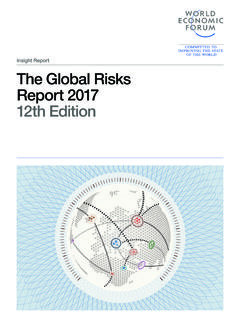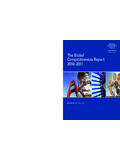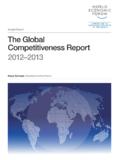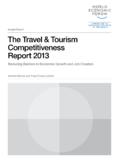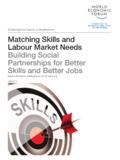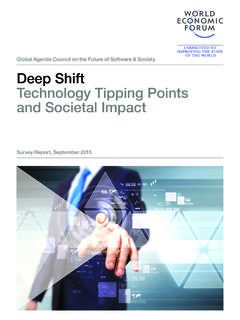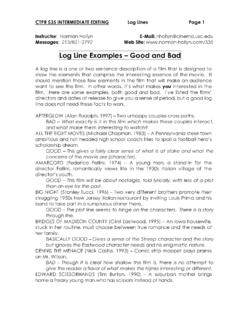Transcription of White Paper Blockchain Beyond the Hype A Practical ...
1 White PaperBlockchain Beyond the HypeA Practical Framework for Business LeadersApril 2018 ContentsWorld Economic Forum 2018 All rights part of this publication may be reproduced orTransmitted in any form or by any means, including Photocopying and recording, or by any information Storage and retrieval 1204183 Preface3 Introduction4 Demand4 The Business Rationale5 Types of Distributed Ledger Technology6 Decision Tree8 Use Cases Use Case: Using Blockchain to Access Distributed GPUs Use Case: Medical InsuranceWhite Paper authors:Catherine Mulligan, Co-Director, Centre for Cryptocurrency Research and Engineering, Imperial College LondonJennifer Zhu Scott, Principal, Radian Partners, Hong Kong SARS heila Warren, Project Head, Blockchain and Distributed Ledger Technology, World Economic ForumJP Rangaswami, Chief Data Officer, Deutsche Bank, United Kingdom 3 Blockchain Beyond the HypePrefaceIntroductionThis common sense and Practical framework is designed to assist executives in understanding whether Blockchain is an appropriate and helpful tool for their business needs.
2 It starts from the premise that Blockchain is merely a technology much like many others that are already used in society and like other technologies it is as much about change management and careful attention to the economics and business models of industries and companies involved as it is about technology evangelism. For any organization, Blockchain technology should not be a goal in itself but a tool deployed to achieve specific purposes. This toolkit is based on real-world experience of Blockchain in a variety of projects across a variety of industries that have been analysed by Imperial College London to develop an initial framework. The framework has been reviewed and further developed by members of the 2017 World Economic Forum s Global Future Council on Blockchain and has been trialled through a variety of means, including with global chief executive officers (CEOs) at the World Economic Forum Annual Meeting 2018 in Davos-Klosters.
3 Over the coming months, the World Economic Forum s Center for the Fourth Industrial Revolution, in partnership with various institutions, will be releasing customized versions of this toolkit focused on specific sectors and use has been an overwhelming amount of hype surrounding Blockchain over the past year. It has been proposed as a solution to such a dizzying array of problems and industries that it is increasingly difficult to keep up, let alone develop a reasoned and sensible approach to the technology. One of the most unique aspects of Blockchain is its high number of evangelists people who believe Blockchain can solve everything from global financial inequality to access to financing for start-ups, the provision of ID for refugees, to solving supply chain problems and enabling people to sell their houses without needing an estate agent. It has started to seem that the most intractable of the world s problems have merely been waiting for Blockchain to arrive.
4 This is not only misleading and untrue but also becomes a barrier to decision-makers in taking a balanced perspective on the technology. The very enthusiasm, therefore, to (over) promote the technology is also the very thing that is damaging its long-term prospects. In addition, a knee-jerk pivot to Blockchain when other existing technologies could suffice not only consumes resources in pointless experimentation but also slows the development of sustainable solutions for the problems at hand, and can even lead to the absorption of unrecoverable costs. Given the relatively early stages of this technology, anchoring on Blockchain without consideration of associated risks, including, among others, cost, security and the relevant industry s regulatory environment, can be level of evangelism is both unwarranted and damaging to the overall development work required to reap the benefits of distributed ledger technologies (DLT), of which Blockchain is the best-known example.
5 In this Paper , the terms Blockchain and DLT will mostly be used interchangeably to refer to DLT. Truly innovative deployments of Blockchain require a match between Blockchain s specific benefits and use cases that enable realization of these benefits, followed by dedicated hard work to get it right and embed in organizations and industries. DLT is not a workaround for business processes, nor is its use a guarantee of stakeholder alignment. It is only once the hard work of engagement and deployment has been done that we will truly start to reap the benefits of the innovation provided by consensus and pseudonymous value transfer. The rest is likely to remain merely the stuff of White Beyond the HypeDemandThe Business RationaleAt the World Economic Forum Annual Meeting 2018 in Davos, an early version of this toolkit was introduced to a workshop of C-suite executives from large corporations, most of whom expressed that they were actively considering adopting Blockchain technology in some manner.
6 One publicly listed energy company discussed its plans for an initial coin offering (ICO), with a focus on broadening its reach to stakeholders and potential customers (instead of raising funds). A traditional bank was considering using Blockchain -based crypto-tokens for transferring remittances. The chief executive officer (CEO) of a large power company noted that the economic incentives for using Blockchain technology to enable micro grid or peer-to-peer energy trading were too great to be ignored. Even in the much-debated cryptocurrency space, 100% of the participants believed that even after the cryptocurrency bubble burst, the token economy would be here to stay. Despite the strong interest in adopting the technology, the group had significant questions and confusion about whether Blockchain would actually address their business needs and had serious concerns about security, immutability and when to use a private or public Blockchain .
7 This confusion is indicative of conversations with hundreds of private-sector leaders over the past year who expressed a need for objective and Practical guidance in cutting through the hype and identifying where Blockchain could add true value to their companies. In direct response to this need, the framework contained below is not intended to serve as a reference tool for Blockchain 101 , as such information is readily available from multiple reliable sources. Instead, it is intended to provide tools for analysing whether Blockchain might be useful for a particular problem. Thus, no prior knowledge of Blockchain is to adopt Blockchain is not merely a technological decision; it is also a business decision. Good use cases must solve real problems for organizations. Great use cases solve real problems at a cost that is significantly lower than the benefits the adoption brings. As the decision-makers within an organization, it is important not to be tempted by the hype but instead to think honestly about whether using Blockchain is a sound business decision even in those cases where a well-defined problem exists.
8 As with any technology deployment, the business need itself is the place to start. Blockchain s unique properties, however, mean that a new analytical framework is useful, in part because of the fact that Blockchain has emerged at a unique point in society s technological development. The ICT revolution has placed cheap and powerful computational capacity in the hands of many people around the globe. As a result, the physical capital for creation and production is now broadly distributed throughout society and in control of individuals, rather than under the control of large-scale entities such as corporations, governments and research institutions. One example of this has been seen in the media industry, with the development of user-generated content (UGC) and the increasing popularity of platforms such as YouTube. Blockchain is very similar to this concept, except that it allows individuals to exchange money and other assets with one another, without requiring an intermediary to do the application of technology to improve business processes is nothing new, previous generations of technology were predominantly about the faster and more secure exchange of information; that is, they were aimed at delivering the same objectives faster ( , back office services such as payroll and accounting were digitalized).
9 Blockchain , meanwhile, is about the exchange of value; it is intended to enable individuals to exchange currency and other assets with one another without relying on a third party to manage the transactions. It also implies the dramatic redefinition of the business processes associated within and between companies. 5 Blockchain Beyond the HypeTypes of Distributed Ledger TechnologyThe three main types of distributed ledger technology (DLT) are: permissionless, public systems; private, permissioned systems; and hybrid systems. Each version is useful to achieve different objectives and meet different requirements. As illustrated below, each has its own unique properties and each has different forms of access control for reading and editing the information on the Blockchain . Moving from right to left across the types of ledger, the level of decentralization increases, while transaction speed , public, shared systems are those that allow anyone to join the network, to write to the network and to read the transactions from those networks.
10 These systems have no single owner everyone on the network has an identical copy of the ledger . In the media, the prototypical example of this is bitcoin, but there are many others. Due to the unique design goals of operating in a completely open environment without any points of centralized trust, and in which potentially malicious actors are not only allowed to submit transactions but also to participate in transaction validation, these systems add an extra component that prevents these activities. The most common method is called proof of work, but there are other models, such as proof of stake and proof of authority. Proof of work is computationally expensive, uses a significant amount of electricity, does not scale well and requires large numbers of network participants to be able to generate trust . However, this approach does allow large numbers of participants to collaborate based on the codes only in a decentralized manner.
